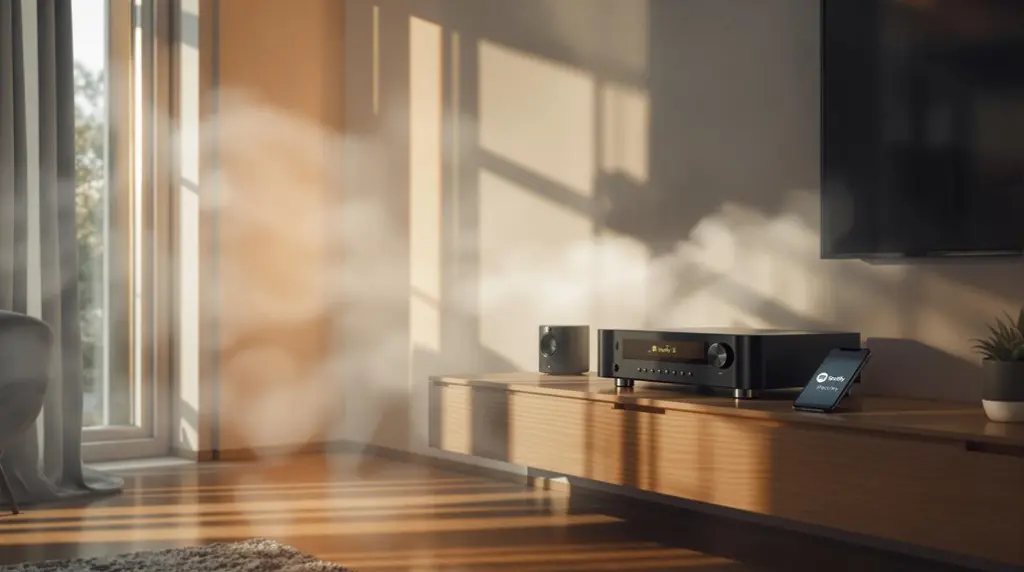Mastering advanced beatmatching involves precise synchronization of complex rhythms to create seamless DJ sets that captivate the audience. It demands in-depth understanding of BPM and tempo variations, phase alignment, and accurate cue point placement. Utilizing advanced DJ software tools like Traktor and Serato enhances beatmatching precision through BPM detection automation and waveform alignment tools. Rigorous practice, such as nudging and dragging techniques, fortifies muscle memory and timing accuracy. Advanced beatmatching techniques guarantee fluid shifts and maintain the dance floor’s energy. As you refine these skills, explore how these methods elevate your DJ performances to professional standards.
Key Takeaways
- Master BPM and tempo control to adapt to various genres and ensure smooth transitions.
- Utilize visual waveforms and beat grids in DJ software for precise phase alignment and cue point placement.
- Practice manual beatmatching to develop critical listening skills and versatility.
- Set multiple cue points at significant track moments to facilitate seamless shifts and maintain energy flow.
- Record and critically analyze practice sessions to identify and improve weaknesses in beatmatching techniques.
The Essence of Beatmatching
Beatmatching, an important skill for any professional DJ, involves the precise alignment of the tempo (BPM) and beats of two tracks to create a seamless auditory experience. This technique is fundamental in maintaining the energy and flow on the dance floor, particularly within electronic genres like house and techno, which typically range between 110 and 150 BPM.
At the core of beatmatching fundamentals is rhythm synchronization, which guarantees the beats of two tracks are perfectly aligned, preventing any audible clash. This process is not merely about matching BPMs; it requires the DJ to align the first beat of each bar across both tracks. This alignment is vital for creating smooth shifts and maintaining consistent musical flow.
Techniques such as utilizing BPM counters and understanding prominent beats like bass kicks are important for effective beatmatching, enhancing the auditory narrative of the set.
While modern DJ software and BPM counters can aid tempo detection, mastering manual beatmatching techniques is indispensable for any DJ aiming to enhance their versatility and technical prowess. Accurate rhythm synchronization demands critical listening skills, which can be honed through regular practice of counting beats and understanding track structures.
Mastering BPM and Tempo
Having established the foundational significance of rhythm synchronization within beatmatching, it becomes essential to thoroughly understand BPM (Beats Per Minute) and tempo to achieve mastery in DJing. BPM is a vital metric for DJs, with genres typically falling within specific ranges—house music around 120 BPM and drum and bass between 140-180 BPM. Accurate BPM detection is fundamental for effective mixing, and modern DJ software provides automated BPM analysis and real-time tempo readings.
Understanding tempo guarantees consistent energy levels across tracks. Mismatched BPMs can cause rhythm clashes, disrupting the dance floor experience. Manual BPM counting skills enhance a DJ’s versatility, allowing them to estimate tempo without relying solely on technology, particularly useful for unanalysed tracks. Regular practice with a metronome or varied BPM tracks hones the ability to adapt to tempo variations and complex rhythmic patterns, ensuring seamless shifts and maintaining groove continuity.
| Genre | BPM Range |
|---|---|
| House Music | 120 BPM |
| Drum and Bass | 140-180 BPM |
| Techno | 120-150 BPM |
Mastery of BPM and tempo, coupled with an acute sense of rhythmic patterns, forms the bedrock of advanced beatmatching, enabling DJs to curate compelling, harmonious sets.
Synchronization Techniques
In the domain of synchronization techniques, achieving impeccable phase alignment and cue point precision is paramount for professional DJs. Ensuring the downbeat and key rhythmic elements, such as kick drums, are perfectly aligned minimizes audio clashes and maintains a cohesive mix.
Utilizing visual tools like waveforms can aid in precise rhythmic alignment, enhancing the smoothness of shifts. Strategically setting cue points at critical track moments, like drops or vocal entries, facilitates seamless shifts and enhances the overall auditory experience.
Phase Alignment Strategies
Phase alignment, a critical component of seamless beatmatching, assures that the beats of two tracks synchronize perfectly, maintaining a cohesive and professional sound during shifts. Central to this process is the art of phase shifting, which involves micro-adjustments to the timing of beats to guarantee they align precisely. DJs must focus particularly on the downbeat, the first beat of a bar, as this is the anchor point for synchronization.
Utilizing visual waveforms available in modern DJ software is an invaluable tool for phase alignment. These waveforms allow DJs to visually pinpoint where beats should align, facilitating precise adjustments. By closely monitoring these visual cues, DJs can preemptively detect and correct phase discrepancies.
Additionally, the auditory method of listening for prominent percussive elements, such as kick drums, aids in achieving exact beat layering, where the beats of two tracks overlay perfectly.
Mastery of phase alignment is refined through regular practice, particularly with tracks featuring diverse rhythms and tempo changes. This hones a DJ’s ability to quickly identify and rectify misalignments, thereby enhancing the overall quality of their mixes.
An authoritative grasp of phase alignment is indispensable for any DJ aspiring to deliver professional-grade performances.
Cue Point Precision
Cue point precision is a cornerstone of advanced beatmatching, enabling DJs to synchronize tracks with pinpoint accuracy. Effective cue point strategies involve meticulous cue point placement at the beginning of significant sections, such as drops or verses, which facilitates seamless shifts and maintains rhythmic alignment between tracks. Leveraging the first beat of every bar as a reference point guarantees consistent cue point accuracy, allowing for flawless synchronization during mixes.
Experimentation is key; during practice sessions, DJs should identify ideal entry and exit points, as these can vary based on the song’s structure. Visual waveforms in DJ software are invaluable tools, allowing DJs to discern audio peaks and troughs for precise cue point placement. Regular practice in adjusting cue points in real-time hones the ability to adapt to tempo changes, maintaining beat alignment throughout performances.
Below is a table summarizing key aspects of cue point precision:
| Aspect | Detail | Benefit |
|---|---|---|
| Significant Sections | Drops, Verses | Enhances shifts |
| First Beat Reference | First beat of every bar | Guarantees rhythmic alignment |
| Practice Sessions | Experiment with entry/exit points | Identifies ideal cue points |
| Visual Waveforms | Peaks and troughs in audio signals | Aids in precise cue placement |
| Real-Time Adjustment | Regular practice during mixing | Improves tempo change response |
Mastering these techniques enhances a DJ’s ability to deliver professional and dynamic performances.
Advanced Cue Point Strategies
Mastering advanced cue point strategies is vital for DJs looking to enhance their mixing capabilities and deliver seamless, dynamic sets. Key to these strategies are cue placement techniques, which involve setting multiple cue points throughout a track. This facilitates quick access to pivotal moments such as drops, breakdowns, or shifts, greatly enhancing mix fluidity.
Utilizing visual waveforms in DJ software, DJs can identify ideal cue points by highlighting notable changes in energy or rhythm, allowing for precise placement within the track. Integrating EQ mixing techniques with cue points guarantees clarity and impact during shifts, while managing bass frequencies prevents overly boomy mixes.
Experimentation with cue points at various beat intervals, such as every 16 or 32 beats, is essential for creating dynamic shift strategies. This approach helps maintain the energy flow during live sets and guarantees continuous audience engagement. Additionally, marking cue points just before major shifts, like vocal entrances or instrumental breaks, helps achieve smoother and more engaging shifts between tracks.
Regular practice in cue point placement allows DJs to develop an intuitive sense of timing and track structure. This proficiency is foundational for more effective and creative mixing techniques, ultimately elevating the overall performance quality.
Advanced cue point strategies, when mastered, empower DJs to execute intricate, high-energy, and enthralling sets with precision.
Utilizing DJ Software Tools
Leveraging DJ software like Traktor and Serato can greatly enhance beatmatching precision through BPM detection automation and waveform alignment tools.
These applications streamline the process by offering auto-sync capabilities, allowing DJs to maintain focus on creative aspects such as cue point precision and seamless shifts.
Advanced features like beatgridding and customizable loop settings further enable accurate alignment and manipulation of tracks with varying tempos and complex rhythms, elevating overall performance quality.
Real-time features in VirtualDJ and the AI-driven Neural Mix™ technology in Algoriddim Djay Pro add layers of flexibility, allowing DJs to experiment with innovative track manipulations.
BPM Detection Automation
In the domain of modern DJing, BPM detection automation has revolutionized the workflow, empowering DJs to concentrate on the artistic aspects of their craft rather than the mundane task of tempo calculation. Leveraging sophisticated BPM analysis techniques, contemporary DJ software such as Serato DJ, Traktor, and Rekordbox, automates the process by analyzing the audio file’s waveform to deliver precise tempo readings in real-time.
| Software | Feature | Benefit |
|---|---|---|
| Serato DJ | Real-time BPM detection | Accurate tempo adjustments |
| Traktor | Advanced algorithms | Detects BPM fluctuations |
| Rekordbox | Auto-sync | Seamless beatmatching |
These automated BPM counters eradicate the necessity for manual counting, thereby enabling DJs to channel their focus towards creative mixing. Advanced algorithms within these applications guarantee that BPM fluctuations are meticulously detected and displayed, facilitating precise automated tempo adjustments even for tracks with varying tempos. Features like auto-sync further enhance the beatmatching experience by aligning the tempo of one track to match another, guaranteeing seamless shifts.
Despite the technological advancements, it remains essential for DJs to hone their rhythm recognition skills, enabling them to make informed decisions and adjustments during live performances. The amalgamation of automation and manual expertise defines a proficient DJ’s capability to master complex rhythms in contemporary DJ sets.
Waveform Alignment Tools
Employing sophisticated waveform alignment tools, DJ software such as Serato DJ and Traktor empowers DJs to achieve impeccable timing and synchronization during their sets. These tools offer a detailed waveform visualization of tracks, enabling DJs to pinpoint the exact moments when beats align, facilitating seamless shifts. By displaying beats graphically, DJs can easily identify essential points like downbeats and shifts, thereby enhancing their ability to place cue points accurately.
One of the standout features is the use of color coded waveforms, which differentiate between various frequency ranges. This visual aid allows DJs to quickly assess sections where frequencies can be cut or boosted, optimizing the mix’s sonic balance.
Advanced functionalities such as beat grids further enhance the precision of waveform alignment. These grids allow DJs to manually adjust the beat placement within the waveform, ensuring that synchronization remains tight even with complex rhythms.
Utilizing these waveform alignment tools not only maintains tempo and groove but also greatly reduces the likelihood of drift. This capability is vital for maintaining the overall quality of the mix, ensuring a professional and polished performance.
The integration of these tools in DJ software is indispensable for mastering advanced beatmatching techniques.
Cue Point Precision**
Mastering cue point precision within DJ software is an indispensable skill that greatly enhances the fluidity and impact of a DJ’s performance. Setting cue points at significant moments in a track, such as the start of a verse or a drop, enables precise entry during mixes.
Utilizing visual waveforms is fundamental for accurate cue placement techniques, as they reveal the structure of tracks, aiding in the alignment of cue points with beats and bars.
Hot cue strategies are essential for quick access to specific sections of a track, facilitating seamless shifts and enhancing the overall mixing flow. Employing hot cues allows DJs to:
- Instantly jump to a predefined point: Quickly navigate to significant parts of a track without missing a beat.
- Create dynamic shifts: Smoothly move between different sections, maintaining energy levels on the dance floor.
- Incorporate creative looping: Use looping features to extend sections, adding layers and complexity to live performances.
Regular practice and familiarization with cue point settings are indispensable to developing a deeper understanding of timing and rhythm.
This continuous refinement will lead to more engaging and polished DJ sets, ensuring an enthralling experience for the audience.
Overcoming Common Mistakes
One essential aspect often overlooked in advanced beatmatching is the meticulous alignment of phases. While BPM matching is foundational, failing to synchronize the phases can lead to a disjointed mix where the beats do not hit simultaneously. This requires precise timing adjustments to guarantee coherent shifts. Developing rhythm awareness is critical, as it allows DJs to intuitively sense discrepancies between tracks.
Additionally, reading crowd reactions can inform dynamic adjustments for maintaining energy and engagement during the mix.
Neglecting to use headphones for accurate monitoring is another prevalent mistake. Without this tool, subtle timing issues between tracks can go unnoticed, resulting in clashing rhythms during live performances.
Over-reliance on DJ software for beatmatching can also be detrimental. While software aids in synchronization, it can hinder the development of essential ear-based skills required for making real-time adjustments.
Mixing tracks from different genres without considering their rhythmic structures can disrupt the flow of the set. Understanding the BPM compatibility of tracks guarantees smoother shifts.
Additionally, not regularly practicing counting beats and understanding musical phrasing can lead to poor timing and unpreparedness when handling complex rhythms. Mastery in these areas is crucial for delivering seamless and professional DJ sets.
Continuous Practice Methods
To address the intricacies of advanced beatmatching thoroughly, consistent and structured practice is paramount. Establishing daily routines, ideally consisting of 30-60 minutes of dedicated practice, is essential for enhancing your beatmatching skills and developing muscle memory.
Within these sessions, employing a metronome can greatly improve your timing and rhythmic precision, ensuring that you maintain a consistent BPM across various tracks. Additionally, understanding the impact of tempo on crowd engagement can guide your practice, helping you align the energy of your mixes with your audience’s expectations.
Incorporate the following methods into your practice environments to optimize skill development:
- Recording Sessions: Regularly record your practice sessions and critically analyze them. Pay close attention to shifts and beat alignment, identifying areas needing improvement.
- Genre and Tempo Variation: Experiment with a wide range of genres and tempos. This exposure is essential for adapting your beatmatching techniques to different rhythmic structures and complexities, ultimately refining your versatility.
- Nudging and Dragging Drills: Focus on drills that emphasize nudging and dragging techniques. This will refine your ability to correct drifting beats swiftly and accurately during live performances.
Frequently Asked Questions
What Is Beatmatching in DJING?
Beatmatching in DJing is a fundamental technique involving the synchronization of two tracks’ tempos and beats, historically evolving to enhance seamless changes. Mastery of beatmatching techniques is essential for maintaining musical flow and audience engagement during performances.
How to Master Beatmatching?
To master beatmatching, hone your ear training and beatmatching techniques by practicing manual adjustments, utilizing cue points, and experimenting with pitch riding. Analyze recorded sessions to identify areas for improvement, enhancing precision and consistency in complex mixes.
What Is the Difference Between Beat Sync and Beat Match?
Beat sync techniques automate beat alignment, simplifying the DJ process, whereas beat match benefits include enhanced manual control, critical listening skill development, and adaptability in live settings where auto-sync features may falter, ensuring seamless shifts across varying BPMs.
Is Beatmatching by Ear Hard?
Beatmatching by ear can be challenging due to the necessity of advanced ear training techniques and refined rhythm perception. This skill demands acute listening, consistent practice, and a deep understanding of musical structure, making it difficult for beginners.
Conclusion
Mastering advanced beatmatching involves not only understanding the fundamental principles of BPM and tempo but also employing sophisticated synchronization techniques and advanced cue point strategies. Utilizing DJ software tools effectively can greatly enhance performance, while awareness of common mistakes allows for continual improvement. Consistent practice is essential for achieving proficiency. Mastery in this domain raises the quality of DJ sets, ensuring seamless changes and a compelling auditory experience for audiences.




